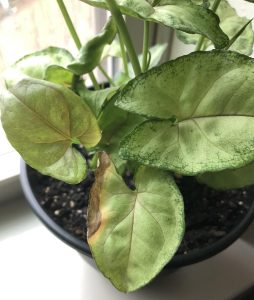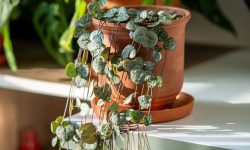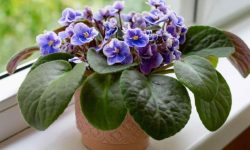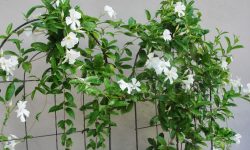The arrowhead plant is also known as the Syngonium plant or Goosefoot plant. Growing and caring for arrowhead plants is quite easy compared to other houseplants. But plant leaves turning brown are the most common Syngonium leaf problems.
Do not panic if you notice your arrowhead plant leaves turning brown. We recommend examining your houseplant to identify the exact cause and fix it. Indoor arrowhead plant leaves turning yellow and brown are a common phenomenon.

Causes of Arrowhead Plant Leaves Turning Brown
Low Humidity
Lack of humidity can cause arrowhead plant leaves to turn brown because it results in insufficient moisture in the air, leading to increased transpiration from the leaves. The dry air will make the leaves start to dry and turn brown.
You can increase humidity around the arrowhead plant by placing a humidifier nearby or using pebble trays filled with water. Another solution is to group plants together, creating a microclimate with higher humidity.
Misting the leaves regularly can provide temporary relief. To prevent low humidity from affecting the plant, maintain a humidity level of around 50% by employing the aforementioned methods and ensuring proper watering.
Overwatering Issue
Overwatering is a common cause of arrowhead plant leaves turning brown. When the plant receives excessive water, the roots become waterlogged, leading to oxygen deprivation and root rot. As the roots deteriorate, absorption of nutrients is compromised, resulting in browning leaves.
Ensure there is proper drainage by using well-draining soil and pots with drainage holes. Allow the top inch of soil to dry out before watering again. If you suspect overwatering, it’s important to check the root health and consider repotting the plant if root rot is present.
Inconsistent Watering
Inconsistent watering can cause arrowhead plant leaves to turn brown due to the stress it puts on the plant. Alternating between periods of drought and excessive moisture can lead to root damage and nutrient imbalances, resulting in browning leaves.
Establish a regular watering schedule based on the plant’s needs. Water thoroughly when the top inch of soil feels dry to the touch, ensuring even moisture distribution. Use your finger or a moisture meter to check the soil moisture level before watering.
Implementing a layer of organic mulch can also help retain moisture and regulate soil temperature. Prevent inconsistent watering by maintaining a consistent watering routine and monitoring the plant’s water requirements throughout the seasons.
Nutritional Deficiency
Nutritional deficiencies can cause arrowhead plant leaves to turn brown because the plant is not receiving essential nutrients for healthy growth. Common deficiencies that lead to leaf discoloration include nitrogen, potassium, or magnesium deficiency.
Lack of nitrogen results in yellowing and browning of older leaves, while potassium and magnesium deficiencies cause marginal leaf browning. To address this issue, fertilize the arrowhead plant with a balanced, water-soluble houseplant fertilizer.
Consider incorporating organic matter into the soil during repotting to improve nutrient availability. Prevent nutritional deficiencies by regularly fertilizing the plant during the growing season and ensuring the soil has adequate nutrient content.
Direct Sunlight Exposure
Exposure to direct sunlight can cause arrowhead plant leaves to turn brown due to sunburn. The intense heat and light from the sun can scorch the leaves, leading to browning and damage. To solve this issue, relocate the arrowhead plant to a spot with bright, indirect light.
If you want to keep the plant near a window, use sheer curtains or blinds to filter the sunlight. Place the plant a few feet away from the window or provide shade using sheer drapes or light-filtering materials.
Excessive Fertilizer Application
Excessive fertilizer application can cause arrowhead plant leaves to turn brown because it leads to nutrient toxicity. When the concentration of salts in the soil becomes too high, it can disrupt the plant’s nutrient uptake and cause leaf burning and browning.
Leach the soil by thoroughly watering the plant, allowing excess water to drain out of the pot. Repeat this process a few times to flush out the excessive salts. Always follow the recommended dosage and application frequency specified on the fertilizer packaging.
Use a balanced fertilizer specifically formulated for houseplants and adjust the dosage based on the plant’s needs. Regularly monitor the plant for signs of nutrient excess or deficiency and adjust the fertilization accordingly.
High Indoor Temperature
High indoor temperatures can cause arrowhead plant leaves to turn brown as it creates a stressful environment for the plant. Elevated temperatures increase water loss through transpiration, leading to dehydration and browning of the leaves.
Ensure the arrowhead plant is placed in a location with an optimal temperature range between 65°F to 75°F (18°C to 24°C). Avoid placing the plant near heat sources such as radiators or air conditioning vents. Consider using fans or air humidifiers to improve air circulation and maintain a cooler environment.
If needed, move the plant to a cooler room during excessively hot periods. Prevent high indoor temperatures by providing proper ventilation, avoiding extreme temperature fluctuations, and maintaining a suitable temperature range for the plant’s well-being.
Arrowhead Leaf Spot Disease
Arrowhead leaf spot disease can cause arrowhead plant leaves to turn brown. This fungal infection is characterized by the appearance of small, dark spots on the leaves, which gradually enlarge and turn brown.
The disease thrives in humid conditions and can be spread through contaminated soil, water, or tools. Remove and destroy the affected leaves to prevent further spread. Avoid overhead watering and keep the foliage dry by watering the plant at the soil level.
Improve air circulation around the plant by spacing out neighboring plants. If the disease persists, apply a fungicide specifically formulated for leaf spot control. Be sure to provide adequate ventilation, avoid excessive humidity, and practice good hygiene by sterilizing tools.
Insect Infestation Problem
Insect infestations can cause arrowhead plant leaves to turn brown as pests such as spider mites, aphids, or mealybugs feed on the plant sap, leading to leaf discoloration and damage.
Identify the specific insect pest affecting the plant and use appropriate control methods. You can wipe off the pests with a damp cloth or use a gentle stream of water to dislodge them. In severe cases, consider using an organic insecticidal soap or neem oil spray to control the infestation.
Regularly inspect the plant for signs of pests and isolate any infested plants to prevent the spread. Maintain good plant hygiene, avoid overcrowding, and periodically inspect plants for early signs of pests.
Poor Water Quality
Poor water quality can cause arrowhead plant leaves to turn brown due to the presence of salts, chemicals, or impurities that can harm the plant. Chlorine, fluoride, or high mineral content in tap water can lead to leaf browning and damage.
Use filtered or distilled water for watering the arrowhead plant. You can also let tap water sit overnight in an open container to allow the chlorine to dissipate before using it. If your tap water has high mineral content, consider using a water softener to reduce its negative effects.
Prevent poor water quality-related issues by regularly monitoring the water quality and selecting a suitable water source for your plants, ensuring it is free from harmful chemicals or excessive minerals.
Final Thoughts from Experts
Understanding the causes of arrowhead plant leaves turning brown and how to address them is crucial to maintain the beauty and health of your houseplant. Low humidity and excess heat are the leading cause of arrowhead plant problems.
We recommend trimming the brown leaves and adjusting the indoor growing conditions. The arrowhead plant will focus on producing new, healthy, and green leaves. Feel free to share with us your experience in dealing with Syngonium plant leaves turning brown.
People Who Read This Also Read:







